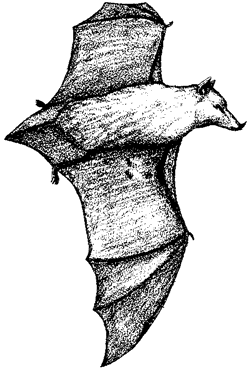
Mexican Long-tongued Bat
Distribution, Abundance, and Seasonality
The long-tongued bat is known only from San Diego Co. An invasion in 1946 provided most of the California records for long-tongued bats (Olson 1947). California records largely have been in urban habitat in San Diego (Olson 1947). In New Mexico and Arizona, long-tongued bats have been found from sea level to 2400 m (6000 ft), occupying desert and montane riparian, desert succulent shrub, desert scrub, and pinyon-juniper habitats.

Range Map
Specific Habitat Requirements
Feeding: The long-tongued bat primarily is a nectar feeder. The diet usually is about 75% nectar, 25% pollen. Fruits occasionally are eaten; insect use is rare. The flight of this species is slow and maneuverable. Hovers while feeding.
Cover: Uses caves, mines and buildings as day roosts, preferring dimly-lit sites (Arroyo-Cabrales et al. 1987).
Reproduction: Uses caves, mines, and probably buildings as nursery sites.
Water: Probably obtains sufficient water from food.
Pattern: In Mexico, New Mexico, and Arizona, occupies deep canyons of desert mountain ranges. Forages in desert and montane riparian, desert scrub, desert succulent shrub, and pinyon-juniper habitats.
Species Life History
Activity Patterns: Peak activity occurs in the first 1 1/2 hr after sunset; then declines to a low level until 3 ? hr after sunset.
Seasonal Movements / Migration: Migrates to follow flowering of food plants, particularly agave and yucca. Winters in Mexico and northern Central America.
Home Range: No data found.
Territory: Long-tongued bats may be found as solitary individuals, or as groups of up to several dozen. Both sexes roost together.
Reproduction: Pregnant females have been found from February through September. Most births occur in June and early July. The single young is furred. Lactation usually occurs from June through August.
Niche: This species pollinates some plants such as agaves and columnar cacti. May share roosts with Plecotus townsendii and Macrotus californicus.
Comments: This species is wary and very sensitive to disturbance of roost sites.
Sources & References
California Department of Fish and Game, 1999.
California's Wildlife, Sacramento, CA.
Written by: J. Harris, reviewed by: P. Brown, edited by: D. Alley, R. Duke
Arroyo-Cabrales, J., R. . Hollander, and J. K. Jones, Jr. 1987. Choeronycteris mexicana. Mammal. Species No. 291. 5pp. Banks, R. C., and J. Parrish. 1965. Additional records of Choeronycteris mexicana from southern California and Baja California. Bull. Southern Calif. Acad. Sci. 64:163-164. Barbour, R. W., and W. H. Davis. 1969. Bats of America. Univ. of Kentucky Press, Lexington. 286pp. Cockrum. E. L., and S. P. Cross. 1964. Time of bat activity over waterholes. J. Mammal. 45:635-636. Hoffmeister, D. F.,and W. W. Goodpaster. 1954. The mammals of the Huachuca Mountains, southeastern Arizona. III. Biol. Monogr. 24:1-152. Howell, D. J. 1974. Accoustic behavior and feeding in glossophagine bats. J. Mammal. 55:293-308. Howell, D. J. 1980. Adaptive variation in diets of desert bats has implications for evolution of feeding strategies. J. Mammal. 61:730-733. Huey, L. M. 1954. Choeronycteris mexicana in southern California and Baja California. J. Mammal. 35:436-437. Humphrey, S. R., and F. J. Bonaccorso. 1979. Population and community ecology. In R. J. Baker, J. K. Jones, Jr., and D. C. Carter, eds. Biology of bats of the New World family Phyllostomatidae. Part III. Special Publ. Mus. Texas Tech Univ., No. 16. 441pp. Mumford, R. E., and D. A. Zimmerman. 1962. Notes on Choeronycteris mexicana. J. Mammal. 43:101-102. Olson, A. C., Jr. 1947. First records of Choeronycteris mexicana in California. J. Mammal. 28:183-184. Struhsaker, T. T. 1961. Morphological factors regulationg flight in bats. J. Mammal. 42:152- 159. Wilson, D. E. 1979. Reproductive patterns. Pages 317-378 in R. J. Baker, J. K. Jones, Jr., and D. C. Carter, eds. Biology of bats of the New World family Phyllostomatidae. Part III. Spec. Publ. Texas Tech. Univ. Mus. No. 16. 441pp.
California Animal Facts | California's Wildlife